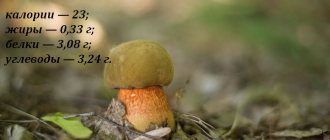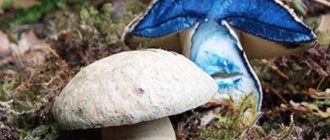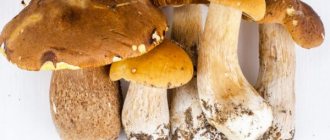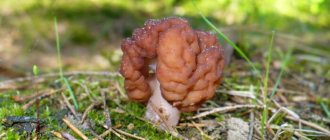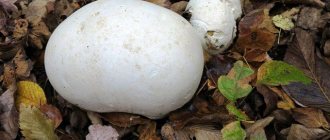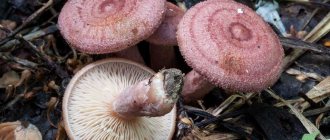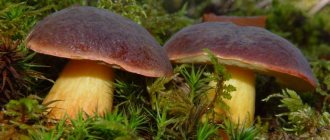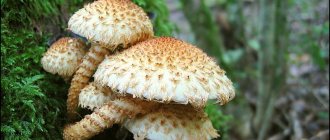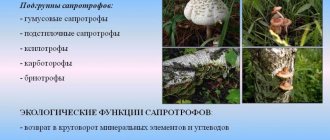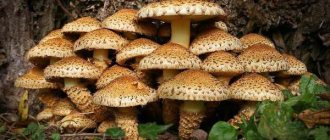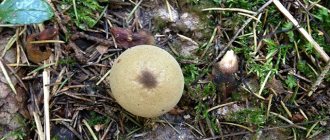Is the oak mushroom edible or not? Boletus lur />Photo and description of the boletus mushroom
The common dubovik is an edible tubular mushroom, known to most mushroom pickers as the mushroom mushroom.
It grows primarily in small groups from late May to October, producing the most abundant harvests from mid-August to late September. It prefers to settle in open areas of mixed or deciduous forests, as well as along roadsides.
The cap is up to 15 cm in diameter, cushion-shaped, velvety, brown or olive-brown, olive or yellow-brown, to red-brown. The color of the cap can vary greatly; it darkens with age.
The pulp is thick, whitish or yellowish (reddish at the base of the stem), when pressed and when cut, it quickly turns blue, then turns brown. The tubes are narrow, yellow, olive-yellow, the pores are orange-purple, and turn blue when pressed. The leg is 5–15 cm tall, thickened at the base, yellow-orange, with a red-brown mesh pattern at the top.
The fungus forms mycorrhiza with oak, beech, and less often with old birch and other deciduous trees; it grows on calcareous soils, preferring bright, well-warmed places by the sun, in May–October. On the territory of Russia it is found in the European part, in Southern and Western Siberia and in the south of the Far East.
Common oakberry belongs to the second category of mushrooms. It is eaten boiled, fried or dried. In some countries of Western Europe, the mushroom is considered conditionally edible, and in North America it is even poisonous. This is apparently due to the fact that, in combination with alcohol, common oakweed can cause mild food poisoning.
Champignon
Champignons cannot be called purely autumn mushrooms, because they begin to appear quite early, some as early as May. However, almost all of their edible varieties bear fruit in September, and some species are found until mid-October.
In our area, I had the opportunity to observe these mushrooms in different places - along the banks of rivers, in forests and meadows, but only where cattle are regularly driven. In the city, on the lawn is a common thing. But the only place where we “collect” champignons is the grocery store.
Is the speckled oakberry edible or not?
Speckled Oak (Boletus erythropus) is part of the Boletaceae family. It is considered conditionally edible. It also has other names:
- red-legged boletus;
- bruise;
- boletus;
- granular boletus;
- grain-footed oakwood;
- subdubnik.
Description
The cap of this mushroom is matte, resembles velvet, and may have mucus. Its size ranges from five to twenty centimeters. It is shaped like a pillow or has a more rounded, spherical shape. The cap is dark brown, black-brown, dark brown, sometimes with an olive or red tint. As the mushroom ages, it becomes bare. When its surface is pressed or damaged, this place darkens and takes on a bluish tint.
The inside of the mushroom is yellow. When a mushroom picker cuts it, the cut area almost immediately turns blue or has a greenish tint. The leg has a barrel-shaped or cylindrical shape, and can thicken towards the bottom as the oak tree grows. The inside of the leg is brown or red, there is no taste or smell. On the outside there are reddish scales and specks. Its color is red-yellow, there is no mesh. Dimensions range from five to fifteen centimeters in height, and up to four centimeters in diameter.
If you look under the cap, you can see olive, yellow-green or yellowish tubes. There are also small round pores that are yellow in color and turn reddish or orange as the mushroom ages. They also darken when injured. The spores are brown-olive, their shape is spindle-shaped, and smooth to the touch.
Places where speckled oak grows
Europe, Eastern Siberia, the Caucasus are the places where this mushroom grows. In the western parts of Siberia and the East it is found much less frequently. Just like in Russia.
Likes to settle under trees such as beeches, fir trees, oaks, and firs. Its roots form a symbiosis with the rhizomes of trees. It also grows in marshy soil, along with moss. The choice of place of growth is influenced by its love for acidic soil. New mushrooms appear from May to October.
Is it possible to eat speckled oakberry?
These mushrooms are conditionally edible. To eat them, you need to cook them for about 15 minutes and then pour out the water in which they were boiled. After this, various dishes can be prepared from oak trees, used for side dishes or sauces. After cooking, they practically do not decrease in size. These mushrooms have a lot of aromatic pulp. When fried, dishes turn out very tasty, their beneficial properties are not lost, and they give off a pleasant aroma. In addition, duboviks can be prepared in any form: pickled, dried, salted. Mushrooms for every taste.
Similar mushrooms
These mushrooms, like many others, have many “brothers” similar to themselves. You need to know this and be able to distinguish between them. These include:
- The yellow boletus usually grows in the western part of Europe. It differs from a bruise in its brown-yellow color.
- Kele's Dubovik is rare. Prefers calcareous soils. It differs in the color of the cap: it is lighter and brownish-yellow in color.
- The olive-brown oak tree has a speckled mesh pattern on the stem.
- Satanic mushroom is a poisonous species. In this case, it is especially important not to confuse the mushrooms. It differs from oak wood in its unpleasant odor. In addition, when cut, it does not immediately turn blue; it first turns red.
Useful properties of speckled oak
Dubovik contains useful substances:
- Microelements: copper, zinc, manganese, iron. Copper promotes the formation of blood cells, participates in the body's metabolic processes and the synthesis of pituitary hormones. Zinc improves the functioning of the gastrointestinal tract. Increases the absorption of various nutrients, improves food digestion due to accumulation in the pancreas. Iron is necessary for the formation of hemoglobin, which carries oxygen in the body. A very small portion of mushrooms contains a whole daily dose of microelements.
- Amino acids improve memory, mental abilities, and lead to normal coordination of movements.
- Beta-glucans are beneficial for the immune system and have a negative effect on cancer cells.
In addition, these mushrooms reduce the risk of atherosclerosis.
Eating speckled oakweed!
It must be remembered that mushrooms are conditionally edible and should be consumed with caution. Children under twelve years old should not eat mushrooms. The fact is that they are specific and “heavy” food. They contain chitin, which has a structure intermediate between plant and animal. It is useful for adults, but is not absorbed in the gastrointestinal tract of children.
https://howtogetrid.ru/dubovik-krapchatyj-opisanie-gde-rastet-yadovitost-griba/
Series of messages "Mushrooms: edible, poisonous": Part 1 - Speckled Oak - description of where it grows, the toxicity of the mushroom. Part 2 - Satanic mushroom - description of where it grows, the toxicity of the mushroom Part 3 - Autumn honey fungus - description of where it grows, the toxicity of the mushroom... Part 21 - Rows and what edible mushrooms look like Part 22 - The most beautiful mushrooms: photos, facts, description.
Medicinal properties of poddubnik
Dubovik is not used as a medicinal plant either in official or folk medicine. But it still has a number of medicinal properties. It contains beta glucans, which have the ability to improve the functioning of the immune system, and also have the ability to suppress the development of malignant cells in the body. Poddubnik contains 18 amino acids , which improve coordination of movements, have a beneficial effect on memory, promote greater brain activity, and have a beneficial effect on blood vessels, reducing the likelihood of developing atherosclerosis.
Also read: Oyster mushrooms as a valuable food product: benefits, rules for their use and possible dangers
In the 17th – 19th centuries, tinctures based on this mushroom were used as a means to tone the body, to relieve stress or depression.
False oak mushroom. Description
Dubovik is one of the most attractive representatives of the mushroom kingdom. It belongs to the tubular mushrooms because it has a clearly defined cap with a hymenophore (tubular layer), which on the inside strongly resembles a sponge. There are two types of oakweed: common and speckled. In principle, they are practically the same, it’s just that the latter’s leg is dotted with small red dots, but this did not affect the taste at all.
The boletus mushroom has a fairly large, cushion-shaped cap. Under favorable conditions, its diameter can reach 18 cm. The top of the cap is covered with velvety dry skin. A young mushroom may have mucus on its cap, but it soon disappears on its own. The color of the cap can vary greatly. In a young fruiting body it is olive-brown; with age, the cap darkens and can reach a reddish or red-brown hue.
The mushroom is distinguished by a strong, smooth stalk. It is cylindrical in shape, closer to the base of the cap it is yellowish in color, and at the bottom (closer to the root) it is red-brown or dark gray. The length of the leg is from 5 to 15 cm. The flesh of the mushroom is dense and strong, without much odor. It has a yellowish tint, but when pressed or broken it instantly turns blue. When processing the mushroom, a blue-violet mark also remains on the fingers. It was this characteristic feature that gave rise to calling it a bruise.
The use of poddubnik in folk medicine
If in the Middle Ages the poddubnik was used in folk medicine, then recently its beneficial qualities have been undeservedly forgotten. And at present, dubovik is not used as a medicine. Although it contains a number of substances that make it useful in relieving fatigue and depression, this mushroom also has antibacterial properties and also helps to improve tone.
Also read: Mushrooms of Belarus: edible, poisonous and spring species
Poddubnik mushroom soup is tasty, aromatic, a characteristic feature of this mushroom is that it does not boil down when cooked for a long time
Poddubnik is an edible mushroom or not. Podbovik mushroom (oak mushroom) - how to use it in cooking
Among amateur mushroom pickers, the Poddubovik (or poddubnik) mushroom is very popular - it is distributed throughout our country and is used in medicine and cooking for preparing various dishes. After familiarizing yourself with its description, places of growth and methods of use, you will be able to use this species with maximum benefit for yourself.
Podbokovik mushroom (oak mushroom)
Characteristic
Tubular mushrooms belong to the Boletaceae family. They exude a pleasant and rich aroma and prefer to grow in groups.
Description:
- in adult fruiting bodies the cap is large - about 15 cm in girth;
- its shape is cushion-shaped, the surface is slightly velvety, dry;
- the usual color is brown with an olive tint, some specimens may be reddish, older specimens darken;
- the flesh of the mushrooms is dense, fleshy, in cross section the fruit is white or pale yellow, the inner part of the stem has a scarlet or reddish tone;
- when pressed or broken, the mushroom turns blue, later turning brown;
- The hymenophore tubes are thin, yellowish in young mushrooms, and red-orange in older ones. When pressed, they change color - turn blue;
- pores are bright orange or purple;
- the leg is tall, reddish, red closer to the top, depending on age, reaches 10-15 cm in height, widened at the base.
Varieties
The group of oak trees (this is what the name sounds like from the point of view of botanical nomenclature) includes several species. In order not to confuse edible mushrooms with false ones when collecting in the forest, you need to read their description.
Olive brown
This mushroom belongs to the group of conditionally edible ones. The color of the cap served as the basis for the name. Its surface is velvety in young mushrooms. The hemispherical shape very rarely opens up to almost flat. The spongy (tubular) layer is orange-red and turns sharply blue even with slight pressure on it.
The leg is club-shaped, yellow-orange, reddish-brown at the base with a pronounced mesh pattern with elongated loops.
The pulp is yellow, dense, and when broken or in the cut area takes on a blue tone with a pleasant aroma. You can find it in mixed or deciduous forest.
Attention! With the simultaneous use of olive-brown oak and alcohol, problems with the gastrointestinal tract may occur.
Mottled
The speckled pomfret is a conditionally edible variety with a round or cushion-shaped cap of a brown hue. The surface is dry, velvety. The leg is cylindrical or barrel-shaped, red-yellow with small carmine-red scales..
The flesh is yellow and very aromatic when cut.
This species is very reminiscent of olive-brown oak. Even their geographical distribution areas are almost the same. In the European part of the post-Soviet countries, it reaches St. Petersburg, is found in the Caucasus, the south of the Far East and isolated in Eastern Siberia.
Kele
Its fruiting body looks like a slightly flattened egg, since the chestnut cap has a rounded-convex shape. It is smooth and velvety on top. The mushroom is considered inedible, although some reference literature suggests that it is classified as conditionally edible.
The leg is cylindrical, thickened at the base, yellowish-brown, without any patterns or scales on the surface.
The pulp is dense, yellow, quickly turns blue when pressed, and there is no mushroom aroma.
On the territory of Russia it is more common in the Caucasus; it has not been recorded further to the north. Habitats are known in the Far East.
How to distinguish from false
The poddubovik has a false double
The edible mushroom has one poisonous variety - the satanic mushroom. If poisoned, it can have the most unpleasant consequences for human health and life.
Irina Selyutina (Biologist):
Characteristic features that allow you to distinguish the satanic mushroom from real oak mushrooms are:
- Hat: shape: hemispherical or rounded-pillow-shaped; surface: velvety or smooth; Color: from whitish to lead-gray, yellow-pink or greenish stains may occur.
- Pulp: a mature mushroom has an unpleasant odor, reminiscent of rotten onions; for a young mushroom – weak, spicy; at the break it first turns red, and only then turns blue.
- Hymenophore: tube color: yellowish or greenish; pore color: in young mushrooms it is yellowish, but in old ones it is carmine-red or red-brown. When pressed, the damaged area turns blue.
- Leg: the mesh pattern is not elongated, but more or less rounded loops; usually dark red, although there are options - white or dark olive; color: sectoral (top – yellowish-red, middle – carmine-red (orange-red), base – brownish-yellow), but the color transition is very smooth; shape: from spherical to barrel-shaped with a noticeable narrowing at the top.
Oak polypore
| Group: | Tubular |
| Records: | From brown with a rusty tint to rich chestnut |
| Color: | From gray to almost black with a brown tint |
| Info: | Woody pulp |
| Department: | Basidiomycota (Basidiomycetes) |
| Sub-department: | Agaricomycotina (Agaricomycetes) |
| Class: | Agaricomycetes (Agaricomycetes) |
| Subclass: | Incertae sedis (uncertain position) |
| Order: | Hymenochaetales |
| Family: | Hymenochaetaceae |
| Genus: | Fomitiporia (Fomitiporia) |
| View: | Fomitiporia robusta (Oak polypore) |
Dubovik kele - description of where it grows, the toxicity of the mushroom
The Kele oak mushroom belongs to the Boletaceae family. They are edible.
Appearance
The shape of the cap is convex, without tubercles. It can be different in size, with a diameter of 6-14 cm. The color is brown, sometimes has a yellowish tint. The surface is matte, but after rain or in wet weather it becomes slippery and smooth.
The leg is hard and dense. At the bottom it is somewhat swollen. The height varies from 6 to 11 cm. Usually the leg is painted yellow; there are small red scales on the surface. White mycelium is visible at the base. When pressed, the leg turns a little blue.
The flesh of representatives of this species is dense and yellow. When broken it quickly turns blue. Insect larvae are found in this pulp extremely rarely. It has a faint odor and a slightly sour taste.
where does it grow
This species grows mainly in deciduous forests, as well as in oak groves. sometimes it can also be seen in conifers. It is very important for them to have enough light. therefore they are often found in clearings. They prefer acidic soil and grow well even in the most infertile soil. You can find oakberry in grass, leaves or among moss. The fruiting period lasts from May and ends only in October. grow several pieces together, often not far from chanterelles, as well as porcini mushrooms and russula.
Inedible look-alikes
In appearance, the oak mushroom is very similar to the satanic mushroom. Confusing them is very dangerous, since the satanic one is very poisonous. A distinctive feature of the Kele oak tree is that its flesh turns blue when damaged. It also has red pores and red speckles are visible on the stem.
Satanic mushroom can be distinguished by its distinct strong odor. His hat is green with a gray tint. When damaged, its flesh also turns blue, but soon returns to its original color. The satanic mushroom has a tuberous stalk, which is usually thicker than that of the oak mushroom. A mesh pattern is visible on it.
Use in cooking
This mushroom can be eaten, but only in cooked form. They must be treated thermally. Only after this will substances that irritate the organs of the digestive system leave it.
These mushrooms are very nutritious, so they are used quite widely in cooking. They have fleshy flesh and a pleasant smell. They are often salted, pickled, added to sauces and soups. To keep them longer, they are dried or frozen. But before putting them in the freezer, you need to boil them. They hardly boil down and retain their beneficial substances.
Application in medicine
The benefit is that this mushroom helps improve immunity due to the fact that they contain beta-glucans.
Eating mushrooms prevents the development of tumors. They help with depression and chronic fatigue. Amino acids improve memory and prevent atherosclerosis. Tinctures and other remedies are made from these mushrooms.
Precautionary measures
Since any mushrooms contain chitin, which children are not able to digest, it is better to start consuming them only after 12 years of age.
Before use, it is recommended to soak the oak wood, draining the water several times. If this is not done, the substances contained in these mushrooms will have a bad effect on digestion.
what are the related mushrooms?
Fechtner's boletus is considered related to Kele's boletus.
this mushroom is also eaten. his cap has the shape of half a ball, but with age it becomes less convex. it is painted white with a silver tint. its surface is smooth, but at high humidity it becomes slimy. The leg of this boletus is solid, tuberous in shape and colored yellow. A reddish mesh is visible near the base. The flesh is elastic, white in the cap, and slightly reddish in the stem. has no aroma and turns bluish when broken. They grow mainly on calcareous soil. prefer deciduous forest. They grow in the Caucasus, and they are also found in the Far East. You can collect all summer. Burroughs boletus is also an edible relative of oak boletus. His hat is large and fleshy. At first it is round, and then becomes flat. It can be white or gray. Sometimes there are specimens with a brownish cap. The stem is white and the flesh is quite dense. They have a rather pronounced aroma and a sweetish taste. You can see representatives of this species in the forest. They grow in North America. They often grow in large groups. They don't grow in Europe.
How to process
Porcini oak mushroom, like most mushrooms, is a perishable product and must be processed no later than within 24 hours after collection. You can extend the shelf life somewhat by placing the mushrooms in the refrigerator.
If plastic bags were used for collection, then in any case the mushrooms should be poured into baskets, for example, as quickly as possible. It is unacceptable to keep collected mushrooms in closed bags, this reduces storage time and leads to their rapid spoilage.
Important! Already 12 hours after collection, up to 50% of the beneficial substances in the oak porcini mushroom are lost.
The beneficial properties of the oak porcini mushroom include the fact that its pre-culinary processing is minimal: special cleaning, as well as preliminary long-term soaking or boiling, is not required.
Important! Pre-treatment of porcini oak mushrooms intended for drying, freezing, and canning is somewhat different from the general scheme.
The general scheme of pre-culinary processing of white oak mushroom is as follows:
- The mushrooms are sorted out and carefully examined, removing forest debris and discarding old, suspicious, and also specimens severely damaged by worms and rot.
- Then the fruiting bodies are wiped with a soft brush or rag to remove forest debris and dirt adhering to them. Use a sharp knife to scrape off stubborn dirt and cut out areas affected by rot and pests. The lower part of the leg is also cut off.
- At the next stage, the white oak mushrooms are washed. To do this, first fill them with water and thoroughly wash each specimen separately, and then all together, changing the water several times.
Next, the mushrooms are soaked in salted water for 15 minutes. After this, the water is drained and the mushrooms are washed well several times, while changing the water. Then put it in a colander and let the water drain.
- After washing, the fruiting bodies are carefully inspected again for the presence of rotten and pest-damaged areas, which are removed.
Rub the entire surface of the mushroom with your hand. If the skin peels off in some place, this is an indicator of spoilage. This skin, as well as part of the pulp under it, is also cut out.
- And finally, the porcini oak mushrooms are washed under running water and placed in a colander to drain.
Advice! Mushrooms intended for cooking can be strained less thoroughly, as they will still be in the water. Porcini mushrooms that are going to be fried or stewed should be kept in a colander for more time.
Edible mushrooms. Types and names of mushrooms with pictures
The best way to independently learn to recognize edible and inedible mushrooms is to familiarize yourself with their names, descriptions and photos. Of course, it is better if you walk through the forest several times with an experienced mushroom picker, or show your catch at home, but everyone needs to learn to distinguish between real and false mushrooms.
You will find the names of mushrooms in alphabetical order, their descriptions and photos in this article, which you can later use as a guide to mushroom growing.
Types and names of mushrooms with pictures
The species diversity of fungi is very wide, so there is a strict classification of these forest inhabitants (Figure 1).
So, according to edibility they are divided into:
- Edible (white, boletus, champignon, chanterelle, etc.);
- Conditionally edible (dubovik, greenfinch, veselka, milk mushroom, line);
- Poisonous (satanic, toadstool, fly agaric).
In addition, they are usually divided according to the type of bottom of the cap. According to this classification, they are tubular (outwardly reminiscent of a porous sponge) and lamellar (plates are clearly visible on the inside of the cap). The first group includes boletus, boletus, boletus and aspen. The second includes saffron milk caps, milk mushrooms, chanterelles, honey mushrooms and russula. Morels are considered a separate group, which includes morels and truffles.
Figure 1. Classification of edible varieties
It is also customary to separate them according to their nutritional value. According to this classification, they are of four types:
- With high taste qualities: saffron milk cap, milk mushroom and white;
- The second category: boletus, boletus, champignons and boletus.
- The third group is the most numerous and includes boletus, chanterelles, trumpets, russula and honey mushrooms.
- The fourth category includes species with the lowest taste: black milk mushrooms, ocher russula, goat and rubella.
Since there are so many types, we will give the names of the most popular ones with their pictures. The best edible mushrooms with photos and names are given in
Edible mushrooms: photos and names
Edible varieties include those that can be freely eaten fresh, dried and boiled. They have high taste qualities, and you can distinguish an edible specimen from an inedible one in the forest by the color and shape of the fruiting body, smell and some characteristic features.
About everyone and everything
The roots of each tree have their own yar or yarnu, that is, as was believed in the old days, the plant power of the soil, especially transferred to mushrooms, therefore only under a certain tree can a mushroom grow and develop, and under any other it will not grow. The great Russian master of mushroom hunting and quiet hunting, Dmitry Zuev, in his wonderful book “Gifts of the Russian Forest” (Publishing House “Forest Industry”, Moscow, 1966) emphasized: “A mushroom without a tree and a tree without a mushroom are not residents.”
So, what trees do mushrooms grow under?
Under the birch: white truffle, white mushroom (short-legged), dubovik (double of the white one), sinik-krasik (double of the boletus mushroom), real milk mushroom (mokhnach), obabok, aspen mushroom, black mushroom berezovik, caesarean mushroom (edible double of the fly agaric), food russula , cobweb, violet row, pushers to (float), red fly agaric, wave, thin pig, green russula, deer sponge, valui.Under the oak: white mushroom (long-legged), speckled oak (white double), blueberry (white double) ), satanic mushroom (an inedible double of the white and oak mushroom), oak mushroom, milkweed (under-nut), pepper milk mushroom, pink russula, gladish milkweed (alder), Caesar's mushroom (edible double of the fly agaric), white mushroom (white trumpet), pigweed, deer sponge, green russula, dry milk mushroom, blue milk mushroom, violin, valui, red fly agaric.
Under the aspen: red aspen, aspen milk mushroom, dog milk mushroom, russula, valui.
Under the spruce: porcini mushroom (the real and most valuable spruce boletus), white truffle, red saffron milk cap, aspen boletus, black birch mushroom, typical raw milk mushroom, black and yellow milk mushroom, red russula (spicy), valui, svinushka, chanterelle, red fly agaric .
Under the pine tree: boletus mushroom (strong boletus mushroom), white mushroom (double of boletus mushroom), orange saffron milk cap, curly drigel (head mushroom), real oiler, green boletus mushroom, yellow-brown boletus mushroom, Polish mushroom (chestnut boletus mushroom), dark red russula , yellow kolchak (blackberry), brittle russula, cobweb, violet row, pigwort, red fly agaric.
Under the larch (in Transbaikalia and Yakutia): camelina, true butterfly, yellow-brown moss mushroom, caesarean mushroom, red fly agaric.
Under the cedar: saffron milk cap, mottled chanterelle, spider web.
Under the poplar: gray birch, aspen milk mushroom, blue milk mushroom.
Under the hornbeam, white mushroom (purple-pink boletus), Vasilkov's hornbeam (a type of black birch).
Under the beech tree: porcini mushroom, truffle, black satanic mushroom.
Under the age-old linden tree: blueberry (boletus double), dubovik (white mushroom), satanic mushroom, pigweed.
Under the alder: white truffle, smooth milkweed (alder).
Under the hazel tree: white truffle, smooth milkweed, pepper mushroom, valui.
What is collected by month in spring, summer, autumn
The table shows the time frame for the appearance of different types of mushrooms. Since the climate in the Tambov region is even, without sharp extreme cold in the autumn, many species are found even after the lower limit. This is especially true for summer varieties, the appearance of which is highly dependent on rain. Rainy summers prolong the period of appearance of summer mushrooms.
| Mushrooms | When to collect |
| Morels | April June |
| Raincoats | May – August |
| Chanterelles | June – September (first half) |
| Boletus | June – September |
| Forest champignons | June – September |
| Reshetniki | June – September |
| Butter | June – October |
| Saffron milk caps | July – October |
| Russula | June – October |
| Rows | June – October |
| boletus | June – November (peak period is August and September) |
| White mushrooms | June – November (mostly from August to October) |
| Poddubniki | July – October |
| Milk mushrooms | July (second half) – October |
| Valui | August – October |
| Honey mushrooms | August – November (summers grow from June to August) |
Poisonous
You need to be especially careful with poisonous varieties. The mushroom picker must be able to recognize them so as not to jeopardize his health and life. Some poisons are so strong that death if ingested is almost inevitable.
Expert opinion
Melnikov Vladimir Mikhailovich
Knows 1000 ways to cook, pickle and marinate any types of mushrooms
The most common and dangerous types of poisonous mushrooms are described below. But do not forget about the main rule - any mushroom whose appearance is in doubt should be avoided.
Death cap
Pale toadstools
The toadstool is characterized by a whitish-green color, and its cap is often (but not always) covered with flakes, like a fly agaric. The shape of the cap can be different - from cone-shaped to completely open. On the leg there is a “skirt” made of film.
This is a very poisonous mushroom that “infects” the entire basket and is harmful to health even through touch. Although death occurs only when ingested. Toadstool can be confused with green russula or light-colored types of rows, so if there is the slightest doubt, the mushroom should be avoided.
Fly agarics
Fly agarics
A large group of poisonous mushrooms that differ from each other in size, color, and cap shape. Most of them are covered with scales. The stem, as a rule, grows from an “egg”, the remains of which can be seen even in adult mushrooms.
It is impossible to confuse fly agaric with a good mushroom - its appearance is too specific.
False honey fungus
False honey mushrooms
The poisonous “version” seems similar to edible honey mushrooms, but only at first glance. Upon closer inspection, you will notice a more aggressive red color than ordinary honey mushrooms. The plates under the cap are also brighter in color - they are reddish-green in poisonous ones and beige in edible ones.
Cobwebs
Very poisonous, but completely unlike any of the edible varieties found in the Tambov region. They are small and thin-legged, with unremarkable color - shades ranging from dark gray to brown. The cobweb can only resemble rotten honey fungus. But since no one will pick up rotten honey fungus, the spider web cannot get into the basket.
Patouillard fiber
Fiber racks
Fiberworts, or inocybe, vaguely resemble honey mushrooms. But in the center of the cap they have an expressive “elevation”, and the color is most often an order of magnitude paler. There are also reddish fibers. They are easily identified by the smell of pepper or medical alcohol. The mushroom aroma is completely absent.
Reddish talker
Talkers
Similar to rows, but much more dangerous. Some types of talkers are simply inedible, while others are deadly poisonous. Shades range from white to pink. Some subspecies can be confused with milk mushrooms, but milk mushrooms have a hole in the middle of the cap, which cannot be said about talkers.
